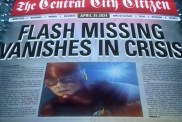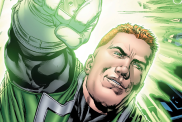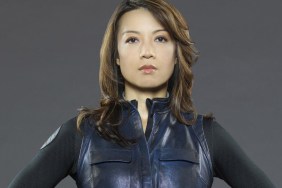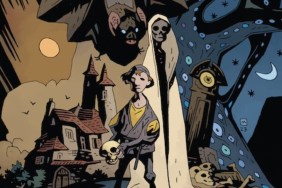
We caught up with the writer/director/producer at Dave’s Tavern on the Smallville set in Plano, Illinois back in 2011.
Question: What was your vision for “Superman” that got this rolling?
David Goyer: Chris (Nolan) and I were working on “The Dark Knight Rises” and we reached writers’ block. Chris said, “Let’s break for a week and just clear our palettes and then come back.” I was tooling around in my office and I just picked up some old “Superman” comic books, started reading them. For about an afternoon I just had this notion for a “Superman” story. At this point, I think they were developing another version with someone else anyway, so I just randomly wrote a couple of pages, maybe three or four pages of a “Superman” movie. Without giving too many spoilers away, it just occurred to me that the story that I was interested in seeing was the story that was about—we knew Kal was an alien, but what made him actually assume this Superman identity and put on a costume? What made him decide, “Oh, I’m going to actually present myself to the world and be a superhero”? I realized that if the world became aware that Kal existed, it would be a first contact story, and in many ways, it would be the biggest thing that ever happened in human history. It would change the world forever, just the sheer fact that he existed on the planet and then subsequently, the knowledge of what he could do, it would force the religions of the world to respond. There would be fear. There would be awe, just the sheer fact that he existed would be the biggest story that ever happened in human history. I realized at least cinematically they’d always just kinda jumped over that, you know? I loved the Donner film, but in the Donner film, he sorta walks up into the north and he throws a crystal and then he comes out of the fortress and he’s in his costume. Then it’s like, “Oh, there’s a guy.” There’s just no—everyone just is like, “Oh, that’s cool. This guy can do all this. Fine.” Then, “Superman Returns” just assumed that you knew all the Donner films as well, and they just jumped over what I thought to me would literally—like I said—be the single most important event in human history. So I had more of the idea worked out, but that was the initial starting point. So I came back to Chris and he said, “So did you crack….?” We were having a problem with the third act in “The Dark Knight Rises.” He said, “Did you figure it out?” I said, “No, but I have this idea for ‘Superman.'” He said, “Oh, all right, fine, what is it?” So, I spent about 20 minutes telling him this story and he said, “Wow! That’s really cool. Do you want me to produce it?” I said, “Oh, I don’t even know that they’re doing something else.” He said, “Well, let’s call ‘em up.” He literally called Jeff Robinov up and said, “Goyer just pitched me a take for ‘Superman.’ We have to do this. I want to produce it. He wants to write it. We need to come in and tell you it.” We came in in a couple of days. I told Robinov and Alan Horn at the time what I told Chris. The next day they scuttled all the other plans that they were doing and made me a deal and I started slowly writing. From that point onward, Chris and I then started doing what we did on—what we do on the “Batman” films. We use index cards for the movie. So that’s about a two month process. Chris and I do really extensive index cards and we meet usually three times a week and we just do board after board after board of index cards where Chris and I beat everything out. Then I went and wrote a treatment and then I started writing and that was the movie. Again, I don’t want to give too much away, but it was really about—this story centers around the fact that the world finds out that Superman exists and he then has to – when we refer to him as an alien, we refer to him as Kal, and when we refer to him as a human, we refer to him as Clark. He then has to grapple with, in effect, does he want to be Kal or does he want to be Clark? That’s his sort of cross to bear in this story. It’s the story of two fathers, Jor-El and Jonathan.
Q: Speaking of Jor-El, since Russell’s (Crowe) training right now, we’re assuming there’s going to be big action sequences. So, can you say about how much we might see of what happens there?
Goyer: Well, I saw some chatter saying that why would Russell Crowe do a cameo? All I’ll say is, it’s not a cameo. It’s a pretty significant role. You will certainly see more of him in this movie than you’ve seen in any other movie. It’s a big role.
Q: How is Clark’s personality different from previous Clarks that we’ve seen? I mean, if you’re going to make a clear delineation between Kal and Clark, who is Clark?
Goyer: Well, character wise, we’re not really making a clear delineation. What I mean is, he has to decide what mantel he wants to assume. He’s sort of been given two sets of moral guidelines. I mean, one of the things that we tried to do in this film was depict Krypton as a truly alien world and not something that was influenced by “Flash Gordon” or Alex Raymond but a truly alien world. One of the things that we decided early on with Krypton, we drilled down really deep all the various art departments in terms of figuring out the history. Some of this we pulled from comic books. Some of this we had to fill in the gaps that didn’t exist. But the gods, the religions, the Krypton, the different guilds and the caste systems, the language we created, a Kryptonian language. So, in all of the—when you see Krypton, there’s a lot of temples and things like that where there will be etchings in stone and all of the things that are rendered in the Kryptonian glyphs can actually be translated into things. So, we wrote each god as a sort of motto in saying each guild has a motto and saying and there’s some Easter eggs in there.

Q: Was it a challenge to find something that didn’t look like something that had been done before, a unique look to it all?
Goyer: Yeah, a little bit. I mean, we’ve had both someone who’s working on the spoken language and a whole department that’s been working on the written language in developing the glyph system has been something that Alex and his team have been working on for six months. There’s been a lot of back and forth on that. Even getting into the S, which isn’t an S, which is one of the Kryptonian glyphs, and what it means. It’s kinda cool because you’ll see that in other iterations throughout the movie. But one of the things that we tried to do was depict Krypton as a legitimately alien world. So we decided that on Krypton, aside from the fact that it’s got a different gravity, it’s got a different atmosphere than we do, it’s a mega gravity planet, so gravity there is anywhere from four to 10 times the gravity on earth. If we went to Krypton, we couldn’t breathe its atmosphere. The sun radiates in a different spectrum of light. Different radiation and things like that, a lot more UV radiation on Krypton. All these things come into play and they also explain why Superman has the powers that he has. But, we also decided that Krypton has a much more formalized and socially stratified society than we do. So we liken Krypton to if you’d taken feudal Japan, but they had never encountered the West and then continued on in that system for the next 150 years, that’s kind of what we imagined Krypton would be like. It’s very formalized.
Q: So you have your samurai and your—?
Goyer: Kind of, yeah. Yeah, there’s a lot of even caste systems and guild systems and different people are allowed to do different things. We also decided that they had been civilized for 100,000 years. So for a much longer period of time. They’d also become a decadent society, and may have become space faring. We’ve been space faring barely for 40 years or something like that, whereas they became space faring 25,000 years ago, something like that.
Q: Are there ways that they don’t look like us that we’re not necessarily seeing or still they do look like us?
Goyer: Maybe.
Q: There was a lot of chatter about the first images, the costume. How much of that costume did you actually write as far as details from the costume? Was that all out of the script?
Goyer: Some of it I wrote. I mean, the costume has a utility and we’re going to explain where the costume comes from and why and he doesn’t just fly into the crystal thing and come out with a costume.
Q: Do you spend a significant amount of time on Krypton?
Goyer: I— Publicist: You’ve never been to Krypton, have you?
Goyer: (Laughs) I’ve been at the sets. You may see more of Krypton than you’ve seen in the other movies.
Q: Is it going to flash back and forth between Krypton and present day?
Goyer: I can’t say. That, I can’t say.
Q: So were any of the comic issues a particular inspiration for you?
Goyer: I’m not going to say. We’ll wait till after the movie comes out. Look, there have been some.
Q: In the “World of New Krypton” they had to build sort of the guild structure.
Goyer: Yeah, I mean, I’m very – look, I’m a big comic book geek and I’ve been reading comic books since pretty much since I was five or six in 1971 or something like that. So, I mean, I read it all and there’s certainly a lot of different iterations of Superman that I personally have enjoyed more than others. Some of them made it in bits and pieces into the movie and there was a couple of like, snippets of lines here or there. I don’t know that it’s – we might see them. I don’t think that it’s referenced by name, but I think there was an Alan Moore issue of DC Comics Presents or something like that. There was one he’d done where Superman gets – or maybe it was a Swamp Thing where Superman gets infected with a Kryptonian virus or something like that and they talk about like, the Blood Moral or something like that. I don’t know. So, I wrote the Blood Moral. You see it. There are a couple of things. There’s Rondor beasts, if anyone knows what that is.
Q: Oh really?
Goyer: Yeah.
Q: I want to know, does Krypton blow up in this movie?
Goyer: Why would I tell you that?
Q: I had to throw that out there just for a denial.
Goyer: “Is the Phantom Zone in the movie?” Why would I tell you that?
Q: You mentioned that you were reading a couple of “Superman” comics and then you decided that you needed to write down this story idea.
Goyer: I literally had gone back just – and this isn’t going to help you. But, I did that – (Laughs) I pulled off, you know the DC Comics Archives, the hardback? It was literally like, that first one of that first like, 10 issues or whatever it was of Action Comics. So I went back. I was just curious to read the very first seven, eight, nine, 10 issues of Action Comics. I was just curious to see how far we had come. It just sparked my – I think they deal with his origin in the first couple of panels and I just remember thinking, “Holy crap. This would be the biggest thing that ever happened ever.”
Q: It was literally just two panels?
Goyer: Yeah.

Q: Because the first four pages were cut out, actually and then not added in until Superman #1.
Goyer: Yeah, but I think that even – I think when (John) Byrne rebooted “Superman” he dealt with it a little bit, but certainly the movies have never – I mean, and I assume some of you are probably pretty seeped in comic book lore, and maybe some of you aren’t as much, but when you’re doing a movie like this or “Batman Begins” or “The Dark Knight,” it’s really important that you respect that, but you also have to understand that in order for these movies to succeed, they have to become a cultural phenomenon that has to explode far beyond what the diehard fans like. So you have to – it’s a really difficult balancing act. I think we were able to achieve it successfully with the “Batman” movies and hopefully we sort of figured out the right formula for this as well.
Q: Well, you’re talking about how it would affect religions and how it would affect people. How much of that do we actually see?
Goyer: You see it. I mean, that’s sort of what the movie’s about.
Q: How do you deal with truth, justice and the American way?
Goyer: You’ll see that a little bit as well, but also, I think that when you see the movie—I know this is going to sound like a cheeky answer—but we don’t have to deal with it as much in this movie as you would think.
Q: I know they kind of skirted it a little bit in the last film.
Goyer: We don’t skirt it. It’s not as much of an issue. When you see the movie, when we’re all talking like, a year and a half or whatever, two years from now, it wasn’t as hard to deal with in this movie as that movie.
Q: Is it more of a Superman belongs to the world and that’s a more prevailing theme in this film? Or does it not factor into it at all?
Goyer: A little bit.
Q: Is it love at first sight with Superman and Lois?
Goyer: No.
Q: How much has changed since Zack got involved? Has it been focused more on action and making this more of an action movie? Has that changed any of the character elements at all? How much has evolved since that?
Goyer: There’s a ton. I mean, look, Zack – I don’t know the exact percentage. I mean, it was a pretty holistic experience. I mean, first it was me and Chris and then it’s been me, Chris and Zack, but I’ll be honest, I thought once Chris started shooting “The Dark Knight Rises,” that that would be the last we’d heard of Chris until they wrapped. But, I’d been on the phone with Chris a shocking amount given the fact that he’s shooting that other movie. I mean, sometimes a couple of times a week he’ll be on the set talking to me. He very much continues to be involved almost on a daily basis, much to his dismay. I mean, because it’s killing him. He’ll be relieved when that movie stops filming. But, it’s changed, but no character stuff came out when Zack got involved. Did that answer your question?
Q: Well, I was just going to say, is there more action and less character now?
Goyer: No, no, there was a lot of action in the version that Chris and I did. I mean, we wanted there to be a lot of action.
Q: What has been the biggest challenge in the relationship between Clark and Kal and Lois Lane?
Goyer: The biggest challenge? Again, I don’t want to give… You know, in this movie, we deal with why Earth, you know, why he was sent to Earth? Why that place was picked out of all the other worlds in the universe or the galaxy and the fact that there might have been a larger plan. Like I said, Krypton is an alien world with a very different set of customs and rules and laws. So things that are appropriate on Krypton aren’t appropriate on Earth and vice versa. He, Kal, Clark, really has a crisis of conscience in this film because he’s forced to decide which set of moral rules he’s going to abide by. Does that sort of answer your question?
Q: Is he referred to as Superman in the movie?
Goyer: Yes.
Q: Does he name himself or does somebody else name him?
Goyer: I won’t say.
Q: That’s important.
Goyer: It is important, but I’m not going to say.
Q: The name itself, was this the name – did you want it to be “Man of Steel,” not “Superman”?
Goyer: Yes.
Q: Okay, why?
Goyer: In part, look, we completely honor the films that have come before, but we wanted to say that there’s sort of a line of demarcation and just on a sub-textual level, it’s about him, the man. I mean, which is not to say – look, he’s in the costume in a ton of the movie, but it’s about him the man. So, this man is both Kal and Clark and Superman and not just Superman, I guess.
Q: Something that I think a lot of us felt was missing from the last one is getting to see Superman punch someone in the face.
Goyer: Yeah, that’s the same with me, same with Chris. I mean, part of the fun I think for us of having a guy that could do these kinds of things is actually seeing, watching him cut loose. So, he definitely cuts loose in this movie, but he also gets his ass kicked in this movie. You get to see both.
Q: I think the biggest criticism of the last movie is that he’s passive. He’s hanging outside Lois’ window not doing a whole lot. So, it sounds like you’ve got a lot of character stuff. So, how do you find the right balance of whatever conflict he’s dealing with that we’ve talked about versus the spectacle that people expect and didn’t get really the last time?
Goyer: He has an enormous amount of conflict that he has to deal with in this movie both on a moral, personal level and on a physical level. But, he’s also given a couple of choices in this movie that are terrible, terrible choices where either decision he makes, a lot of people are going to get hurt. So, one part of the fun and the challenge for us in this movie was for a guy that can supposedly do anything, can you put him in a situation where there may not necessarily be a right answer? Or, where even somebody who can do anything maybe can’t do everything?
Q: Force him into a “Sophie’s Choice” type of thing?
Goyer: Maybe.
Q: It seems like one of the challenges of writing “Superman” is if he’s too powerful, then he’s god-like and where do you come up with a legitimate threat?
Goyer: There’s that, but there’s also – and I think we have come up with a legitimate threat, but the thing that we really, really, really focused on in this film was wanting the audience to identify with him, which for me, was always the challenge with the Superman character was I identified with Bruce Wayne or Batman. It was easier to pretend I could be him, but it was a lot harder to pretend I could be Superman or identify with him. He’s a guy that seemed like he didn’t have a lot of problems because he could do anything. So, I think we worked really hard to get you to identify with him and to get you to identify with the – he has a tremendous weight on his shoulders and a tremendous responsibility. Sometimes that could make him lonely, but like I said, it’s not just coming up with the physical threat, but he’s presented with a couple of choices in this movie that are terrible choices that I think hopefully people will identify with and emphasize with.
Q: Do you guys do the Kryptonite thing of Kryptonite being his weakness?
Goyer: Can’t say.
Q: Has the last movie put Lex Luthor on the shelf for a certain period of time to some degree?
Goyer: Can’t say. Chris and I talked about what—and Zack—what things we would just say and things we wouldn’t say, so sorry. I think I’m telling you guys a lot!

Q: You are, yeah. What is your take on Zod? What was your approach to Zod because everyone remembers Terence Stamp.
Goyer: Who I love.
Q: Who you love, but when you look at the second movie he’s a little bit comedic in some ways. Like, some aspects of that don’t hold up as well in the Lester film.
Goyer: I guess my response would be, when we were working on “The Dark Knight,” there was a lot of chatter about how Heath (Ledger) could never compare to Jack Nicholson’s The Joker. Jack Nicholson was the iconic Joker and he could never compare to him. I think when “The Dark Knight” came out, Jack Nicholson is still a cool joker, but the Jack Nicholson as The Joker existed—this is what I was talking about earlier—in a comic book movie, whereas Heath Ledger’s Joker existed in the much more real movie. I think he’s scary in a way, perhaps Jack Nicholson’s Joker wasn’t. One was a cartoon, one wasn’t. To a certain extent, that’s the same thing that I think you’re going to see with Zod. I loved “Superman,” the first “Superman” and I loved “Superman 2.” I loved Terence Stamp as Zod, but that was a much more arch, broad comic book type of film and character whereas what Shannon is doing with Zod isn’t. We really get into a lot of his backstory and he’s a very complex character, Zod.
Q: Does Kal-El and Jor-El still exist? Does Jor-El still have that place of upper echelon in Kryptonian society? Is he still a scientist?
Goyer: He’s up there. He’s up there.
Q: What made you decide to go with the indestructible version of the suit as it appears to be since I see no rips? (Referring to action scenes we just watched being filmed)
Goyer: We explain that in the movie. You’ll see. There’s a reason for this suit to exist that you’ll see in the movie. Again, even the way it looks is sort of explained and what it does and what it’s used for is explained in the movie.
Q: Obviously he doesn’t have the curl or his underpants on the outside. What did you feel was okay to tinker with and what was not okay?
Goyer: Look, I will say that every decision in this movie came down to that was debated endlessly by all the different departments, by Chris, by Zack, by me, by the guys at DC. You know, there were no capricious decisions. I mean, ultimately, based on what we’re using the suit for in the movie in terms of explaining why it’s there, the underpants, it made no sense. Then, we also heard that they (DC Comics) were doing away with them. It wasn’t that synchronous with DC that they were doing away with them as well.
Q: So there was some coordination with the comic books?
Goyer: Well, yeah, we were talking with them. It wasn’t like a mandate that we heard about that. Again, like I said, Chris approaches everything from the story. So, what’s right for the story? Chris said, “I can’t think of a possible reason why, for what we’re using the suit for in this movie, it would have underpants.” He said, “Can you?” I said, “No.” So that was where we started from. But it’s similar to – I had this experience when we were at DC where I said to Paul Levitz at the time, they call them scallops on Batman’s gauntlet. I pointed to a poster and I said, “What are those?” He said, “Oh they’re just design features.” Chris said, “Bulls**t.” He said, “There can’t be anything on Batman’s costume that’s a design feature.” He said, “Goyer, figure out something.” So I said, “Okay, what if they’re metal gauntlets and he can use them both offensively and defensively to trap weapons?” Chris said, “Done.” So, but that’s sort of the way Chris approaches everything. He’ll never do anything just because it looks cool. There has to be a utility.
Q: You couldn’t come up with anything for his underwear to be like that?
Goyer: (laughter) Not for what…
Q: He’s wearing them under his tights like real men do.
Goyer: Yeah.
Q: What outside influences are there outside of the comic book world?
Goyer: On this one?
Q: Yeah.
Goyer: The biggest ones were the Old Testament and the New Testament. I mean, serious. It’s an Old Testament and New Testament story. I mean, there’s obviously echoes of the Moses myth and there’s echoes of Christ’s story. I mean, I would say those are the biggest ones. I’m trying to think if there were any others… You know, like I was reading Robert Crumb’s “Genesis” – oh, “Gilgemesh”. That’s another one, sorry. I knew there were some. Yeah, I read a lot of different versions of “Gilgemesh.”
Q: In what we saw filming just on the street, you’re trying to get a lot in camera, but are there a lot of really big kind of effects, heavy kind of sequences?
Goyer: You mean visual effects?
Q: Visual effects sequences that you can talk about?
Goyer: Sure, you mean coming? Yeah, there’s a ton. I mean, there’s a lot of action and a lot of visual effects, but they are doing a lot of stuff in camera. When Zack told me that he was going to shoot this movie handheld I was very excited because that decision alone – Superman, just because of what he can do in the costume, there’s sort of a higher burden in terms of making it feel real. So, what really excited me about shooting it handheld is there’s a ton of effects and things like this in this movie, but it’s all handheld, so there’s an immediacy to it that I was telling this to – sorry, one of your foreign contemporaries. But, the first week of shooting was the first couple of weeks there’s a lot of stuff with Costner and Diane Lane. So we were shooting some stuff on the Kent Farm and it was magic hour, so it was dusk and we were out in the fields. There wasn’t any video village, so it was just a small group of us and we were shooting with available light, handheld and Amir (Mokri) was doing the camera. So it was like, Zack and I and a couple other people and a small crew of maybe 20 people and Costner and the young boy playing Clark. Someone asked me earlier, “What’s it like growing up as a comic book geek doing this?” I grew up in Michigan, so where we were at was very similar to the place I grew up in. This is, I think, the second day of shooting. It’s a scene in which Jonathan tells him, “You’re not human,” essentially. I just turned to Zack and I said, “Can you believe we’re doing this? I mean, this is so amazing.” But, more to the point, the scene that we were shooting, stylistically, it reminded me of something out of “Days of Heaven,” the Terrence Malick film rather than a comic book movie because a lot of the movie – there are moments like that that are really cool. It’s much more textural than I think people will expect.
Q: I’m curious, Superman’s known for certain powers, vision, being able to see through things. Do you incorporate all the powers that we know of Superman and do you add anything or do you take anything away from his Rolodex of abilities?
Goyer: He’s got a pretty deep Rolodex. So, I won’t say that we incorporated all the things we know. We handle a lot, and I’m pretty sure we’re depicting a couple in this movie that haven’t been seen on screen before, maybe. I’m not positive. I think our approach would be he might develop more as he goes on. We kinda came up with the approach the longer he is on Earth, then the more exposed to our sun and our atmosphere, the more things he might develop.
Q: Like a super kiss? (laughter)
Goyer: Maybe.
Q: You guys did a trilogy for “Dark Knight.” Obviously, Warner Brothers really wants “Superman” to be a big franchise for the studio for synergy across all departments. Did you guys walk into that initial meeting saying, or do you have that idea of, “This can be a great trilogy”? Obviously, the studio is not going to spend this much money for one picture.
Goyer: They’re hoping there’ll be more.
Q: So when you were first writing that first day or when you started talking with Chris about it did you start thinking about an overarching arch for the story?
Goyer: Chris hates approaching movies that way. It would be disingenuous to say that the studio isn’t hoping that this will spawn another two or three movies. But, Chris doesn’t like approaching things that way and he hates doing sequel bait or just deliberately planning things that would be used in other movies. There are a number of times where I came up with an idea and I said, “Oh, I have an idea, but if we did that, we’d kind of shoot our wad. We might want to save that.” Chris said, “Don’t say that. Just shoot your wad.” Only because he said, “Let’s make the best movie we can possibly make and worry about the sequel later.”
Q: Would you like to do a “Justice League” movie?
Goyer: I don’t know, honestly. I go back and forth. I mean, I think that on “Batman” and “Superman,” Chris has taken a different approach. I love the Marvel films and they’re really fun, but he’s definitely taken a different approach so far, which is that each of these movies is its own cohesive universe and at least with “Batman” it seems to have worked out. So, I don’t know. I’m not sure. I think it would depend with who. This has been a dream experience, so it’s hard to imagine it getting better than this, maybe it could be.
On the NEXT PAGE, you can read our interview with producer Charles Roven.








